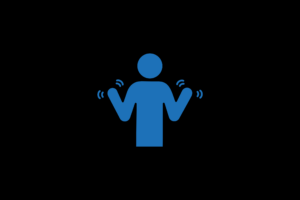Apraxia, or its milder version dyspraxia, is relatively common amongst autistic people. It affects the movements that our muscles make and can impact one motor skill like speech or it can affect all of our motor skills. It can range from mild dyspraxia, where you are seen as clumsy or awkward in your movements, to severe apraxia, where your body rarely does what you want it to.
What has been recently discovered is that the reason most non-speakers can’t speak is because of apraxia. Before it was believed that they couldn’t speak because they didn’t understand language, but this has been proven completely untrue! It’s a result of how the muscles control the movements we need to make the sounds.
What is it like to be apraxic or dyspraxic?
Imagine you are told to throw a ball. Most people can use their bodies to do the action automatically and don’t have to think about it at all.
If you are apraxic or dyspraxic, you have to tell your arm exactly what to do. What muscles to tense, what muscles to relax, when they need to tense and relax, what angles do your arm, wrist, hand and fingers need to be at in order to successfully throw the ball where it needs to go. Remembering to communicate all those instructions to your body is not so easy. The brain doesn’t seem to have the automatic instructions that everyone else does. Imagine having a controller for a game but the controller doesn’t work properly – maybe nothing happens when you press the button, maybe you end up going left instead of right, or there is drift or lag or maybe the character starts jumping instead of standing still.
So when we go to throw that ball, our arm may not move, we may release too early or throw it hard into the ground, or instead, our body could decide to run around instead. It can be so frustrating!
The more complex an action is, the more likely that the instructions will go wrong. So a big movement like waving an arm may be possible but not pointing because that also involves hand and finger control as well as the arm. Speech is an even more complex action requiring lots of muscles to follow instructions together, and so this is why the term apraxia is most associated with non-speaking autistic people.
Is it possible to improve motor skills?
The good news is that we can teach our brain how to do things by building muscle memory. Often we need to break movements down into smaller actions first, and build up our skills from there.
For instance, drawing or writing can be really difficult if you are dyspraxic and your hand is not getting the right instructions for what you want it to do.
To improve on these skills you would need to first build muscle memory in the arm – getting it to move from the shoulder to draw out shapes. Then, keep repeating the movement over and over again until you no longer have to focus on what your arm is doing – it just does it. After that, you can add in wrist movements and keep adding extra movement steps until you reach your goal.
It takes a lot of work and patience to build muscle memory – so it has to be for things we think are really worth it. We can easily end up failing ten thousand times before our brain finally goes ‘Oh I’ve got it now’. It can be really frustrating so we might choose to give up if it’s not something we really want to achieve.
For instance, my everyday handwriting is terrible, but I can do wonderful swirly calligraphy. I practised to the point that, if I focused and concentrated on nothing else but slowly forming beautiful letters, I could produce beautiful writing. It would have taken many more years, doing hours and hours of practice to get my hand to do it without thinking – and for me that wasn’t worth it. I had a lot more interesting things to focus on and learn, things that were important and helpful to me. As an adult, I have realised that texting uses much less complex motor skills and is so much more accessible, so I very rarely need to use a pen.
When you are dyspraxic, it is a fine balance between how much time you will have to put into mastering a skill and whether there’s an alternative way to do it that doesn’t need as much practice – like using texting instead of writing or having a chopping guide tool to keep cuts even and straight when chopping food. There might be some movements and skills that you feel are worth persevering and practising no matter how many repeated failures you have to experience first – for instance you might really want to learn to draw or maybe ride a bike.
There might be times when a skill could be too far out of reach for you at that time. Instead, you may choose to first put your hard work and focus into building up muscle memory for a skill that will improve things for you in the shorter term, like using a letter board to communicate.
Everyone has to practise when they are learning or improving their skills. However, not everyone has to teach their muscles first.



